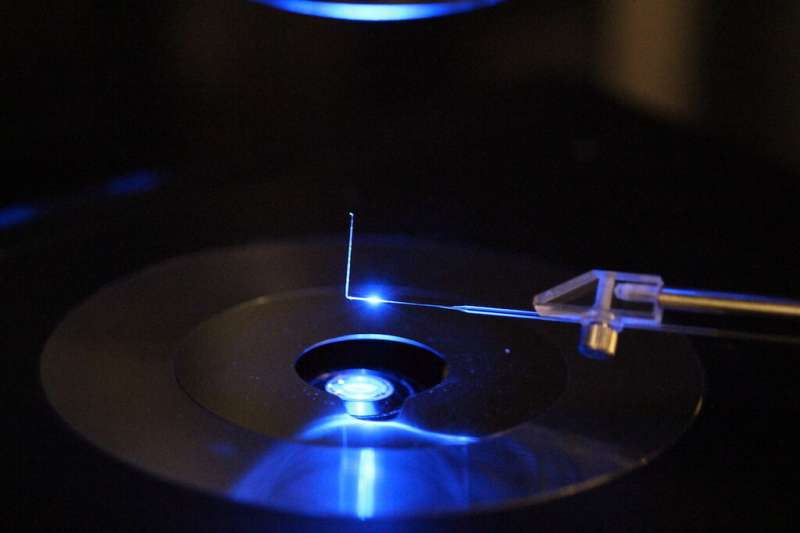Micropipette force sensor under the optical microscope. Credit: Dr Oliver Bäumchen / MPIDS
Forces exerted by a living cell or a microorganism are tiny, often no larger than a few nanonewtons. For comparison, one nanonewton is the weight of one part in a billion of a typical chocolate bar. Yet, for biological cells and microbes, these forces are enough to allow cells to stick to a surface or microbes to propel themselves toward nutrients. Scientists from Finland and Germany now present a highly adaptable technique using micropipette force sensors to precisely measure the forces exerted by a wide range of micron-sized organisms. This novel method has now been published in Nature Protocols.
To stay alive and proliferate, a biological cell needs to adapt to its environmental conditions. The ability to do so involves physical principles and mechanical forces. Cells may attach themselves to surfaces and other cells to eventually form a biofilm, a structure which protects the community of cells from external attack. Many microorganisms can actively move themselves by crawling on a surface or swimming in liquid, for example, toward a source of nutrients. In order to advance the understanding of microbe motility, it's important to measure the mechanical forces associated with their movement.
The development of micropipette force sensors to measure forces of living cells and microorganisms is described in a joint work by Dr. Matilda Backholm and Dr. Oliver Bäumchen. "The working principle of the micropipette force sensor technique is beautifully simple: By optically observing the deflection of a calibrated micropipette, the forces acting on the pipette can be directly measured," says Matilda Backholm, researcher at the Department of Applied Physics of Aalto University in Finland.
By measuring how the end of a C. elegans moves a pipette tip, we can calculate the forces produced by these worms and microorganisms as they move. Credit: Dr Matilda Backholm, Aalto University Dr Oliver Bäumchen, Max Planck Institute for Dynamics & Self-Organization
A micropipette is a hollow glass needle with a thickness of about the diameter of a human hair or even smaller. One of the most remarkable advantages of this technique is that it can be applied to a large variety of biological systems, ranging from a single cell to a millimeter-sized microorganism. "We exemplified the versatility of our method using two model systems from microbiology, but certainly, the technique can and will be applied to other biological systems in the future," says Oliver Bäumchen, research group leader at the Max Planck Institute of Dynamics and Self-Organization in Göttingen, Germany.
"The idea behind the technique is to combine the advantages of several established biophysical techniques. We use a micropipette to grab a living cell in the exact same way as it is done in in-vitro fertilization, and study the mechanical forces by measuring the pipette's deflection using the measurement principles underlying atomic force microscopy—a standard measurement technique in physics," says Bäumchen.
Dr. Backholm points out another major advantage: "In contrast to other force measurement methods, we detect the deflection of our highly sensitive micropipette simply by observing it with a state-of-the-art microscope. This allows us to inspect the shape and motion of the microorganism with high optical resolution, while we are measuring the forces simultaneously."
During all of this, the cell or microorganism is fully intact and alive, which allows for testing its reaction to drugs as well as nutrients, temperature and other environmental factors. "The force resolution is really remarkable. With our recent technological advancements, we successfully managed to detect forces down to about ten piconewtons, which is almost as good as an atomic force microscope," says Dr. Bäumchen.
The researchers expect that their method will be applied in other research labs in the future to tackle important biophysical questions, aiming at better understanding biological functions of cells and microorganisms, as well as their underlying physical principles. Dr. Backholm points out that these research avenues may indeed advance biomedical and biotechnological applications: "The micropipette force sensor technique might help to identify drugs for fighting infectious diseases and inhibiting the formation of biofilms on medical implants, just to name a few examples where this novel approach might make a significant impact."
More information: Nature Protocols (2019). DOI: 10.1038/s41596-018-0110-x
Journal information: Nature Protocols
Provided by Aalto University
























